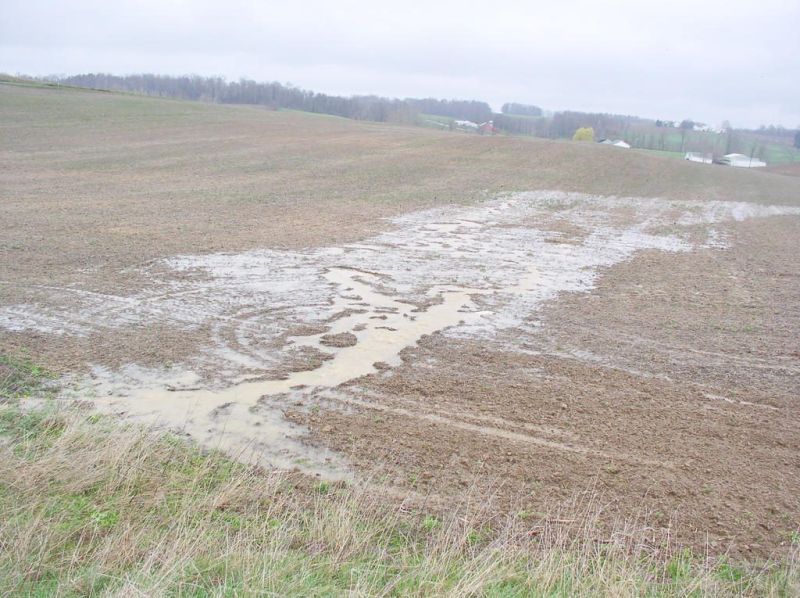What can you do to prevent the loss of top soil?
- Joe Christner: SWCD
- April 10, 2018
- 2150
Soil loss may be one of the most damaging aspects of production agriculture. It has a tremendous effect on both soil health and water quality. Under the best-case scenario, soil can only rebuild at a rate of 0.24 tons per acre per year.
When you’re losing soil, you’re losing both yield and money. This information should raise some important questions, the first being: Do you know how much soil you are losing from your farm?
Judging soil loss is difficult, as indicated by a recent survey among farmers. A recent survey showed 42 percent of farmers estimated they averaged less than one-fourth ton per acre annual soil loss in 2016 with another 38 percent saying one-fourth to 1 ton per acre.
However, to achieve such an extremely low erosion rate, you’d have to be doing zero tillage on a nearly flat field. The average soil loss rate is more than 5 tons per acre per year based on The Revised Universal Soil Loss Equation.
This is a tool that calculates soil loss based on soil loss factors. The equation is A=R*K*LS*C*P. A equals tons soil per acre per year. R equals rainfall and runoff factor. K equals soil type erodibility factor. LS equals slope factor (length and steepness). C equals crop and cover management factor (compares crop rotations, tillage and percent cover residue at planting). P equals conservation practice factor (contour and or strip cropping).
Each of these five factors affect the amount of soil lost by erosion. The first three are a given including soil type, slope and weather. There is not a lot we can do to change them. However, we can make changes to the last two factors.
The changes we make in crop and cover management and conservation practices will either increase or reduce soil loss. Crop and cover management includes crop rotation, tillage and cover crops. Conservation practice factor includes farming on the contour and/or strip cropping. Over the last several years we have seen changes in crop production management systems.
There may be good reasons for these changes, but the result is an increased risk of erosion and soil loss. Less small grain and hay in crop rotations, larger equipment resulting in loss of contour strips, increased tillage, and more intense rain events may be increasing soil loss from our fields.
What is the cost of a ton of soil loss? This cost may not be obvious, but it is real. Based on a recent call to a local contractor, a ton of top soil will cost you around $20 delivered. Also keep in mind that when you are losing soil, you are losing yield. Research from Iowa and Missouri indicates this yield loss potential could be as high as 15 bushels per acre per year. You also are losing valuable nutrients attached to the soil that you will have to replace.
Do you know how much soil loss is occurring on your farm and what is the cost to your operation? If you don’t know, it is difficult to do something about it. Holmes SWCD can help find answers for your operation using The Revised Universal Soil Loss Equation.
What can you do to prevent the loss of top soil?
No-till or reduced tillage: This will maximize the residue on top of the ground and improve soil structure resulting in less top soil moving off your fields.
Cover crops: There are many benefits to cover crops, but reducing soil loss ranks at the top of the list. A cover crop can protect your soil during the time between cash crops.
Crop rotation: Adding small grain or hay to your rotation will function like a cover crop and may allow for more cover crop options.
We all know there is a cost associated with each of these practices. No-till may yield less for a few years. Covers crops cost money to plant. Corn/soybean rotation may be more profitable than adding wheat or hay. But there also is a cost to losing your top soil. So the biggest question is: What are the costs for my operation?
With tight profit margins you may be reluctant to spend more money even on practices that reduce soil loss. I understand. But if you save the money by not spending on these practices, you will risk the costs of soil loss. Do you want to invest in practices that save your top soil or pay for the cost of erosion and soil loss? You get to choose.
You don’t have to make all the changes at once. Think of it as a big sandwich. Plan to take a small bite every year by planting a cover crop on 20 percent of your acres. Or add wheat or hay to 20 percent of your acres each year. Or you may want to try no-till or minimum tillage on some of your fields.
In summary, make a commitment to preserving the top soil and guarding against the future cost of replacing it. That commitment can result in keeping your soil where it belongs.
Joe Christner is the water quality technician for Holmes Soil & Water Conservation District. Email the SWCD at holmes.swcd@gmail.com, call the office at 330-674-SWCD ext. 3 or go to www.HolmesSWCD.com.

